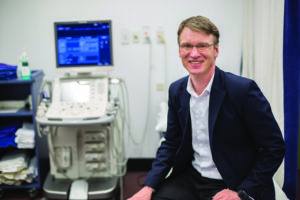Aneurysm breakthrough
26/06/2018
University of Otago vascular researchers have developed a process that could revolutionise aneurysm management – and save lives.

An aneurysm – a blood-filled bulge in a weakened blood vessel wall – is most commonly found in the aorta. Often described as “ticking time bombs”, aneurysms can be managed if they are detected early. There are aortic aneurysm screening programmes for those considered high risk, but Professor Greg Jones says the 30mm measurement used to define an aneurysm is based on the average size of blood vessels in men. This does not account for differences in body size, particularly in women. When blood vessel measurement is adjusted to reflect body size, his team showed that men and women have similar risk.
“The New Zealand study clearly showed we are underestimating the true prevalence: women and smaller men have more chance of having an aortic aneurysm than health professionals previously realised.”
This is a particular problem in New Zealand, with a high prevalence of Māori women who smoke and are, therefore, at higher risk. “Using this false assumption has likely contributed to a health inequality.”
The researchers are working with a national consortium of vascular surgeons on a pilot study to test a new screening programme with standards taking body size into account. The bench-to-bed research has taken a basic interest in biology through to community health delivery. “It’s a game changer that will save lives, but the discovery is controversial, as global screening programmes are based on a belief that aortic aneurysms are a disease primarily of men. This assumption will have to change.”
Professor Greg Jones: “Global screening programmes are based on a belief that aortic aneurysms are a disease primarily of men. This assumption will have to change.”
Professor Greg Jones is the Chair of the Scientific Committee on the Otago Medical Research Foundation Board.